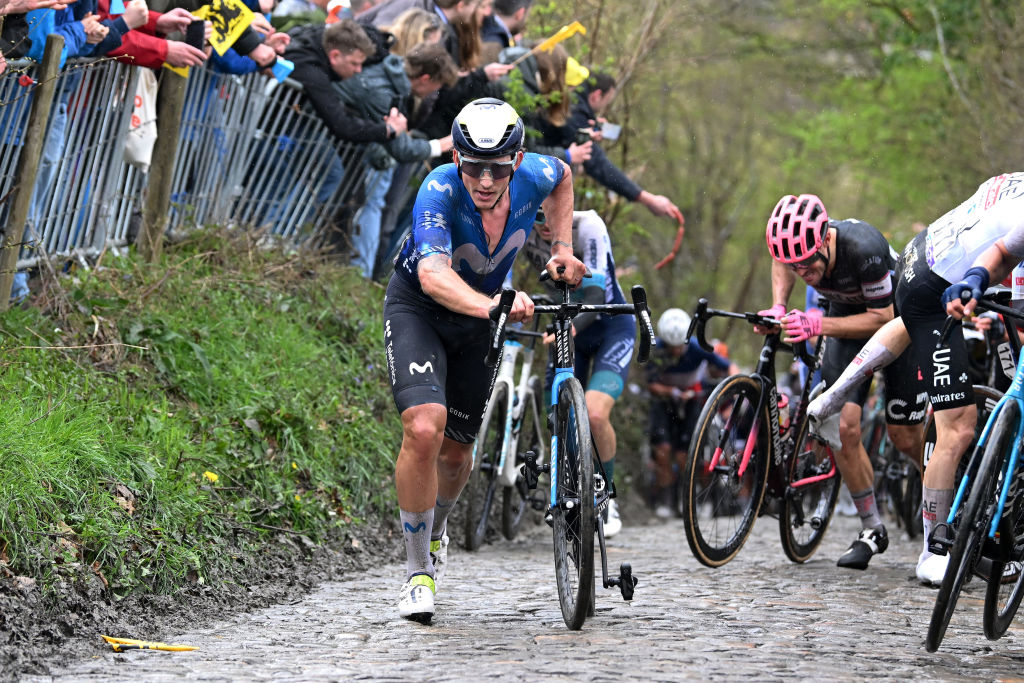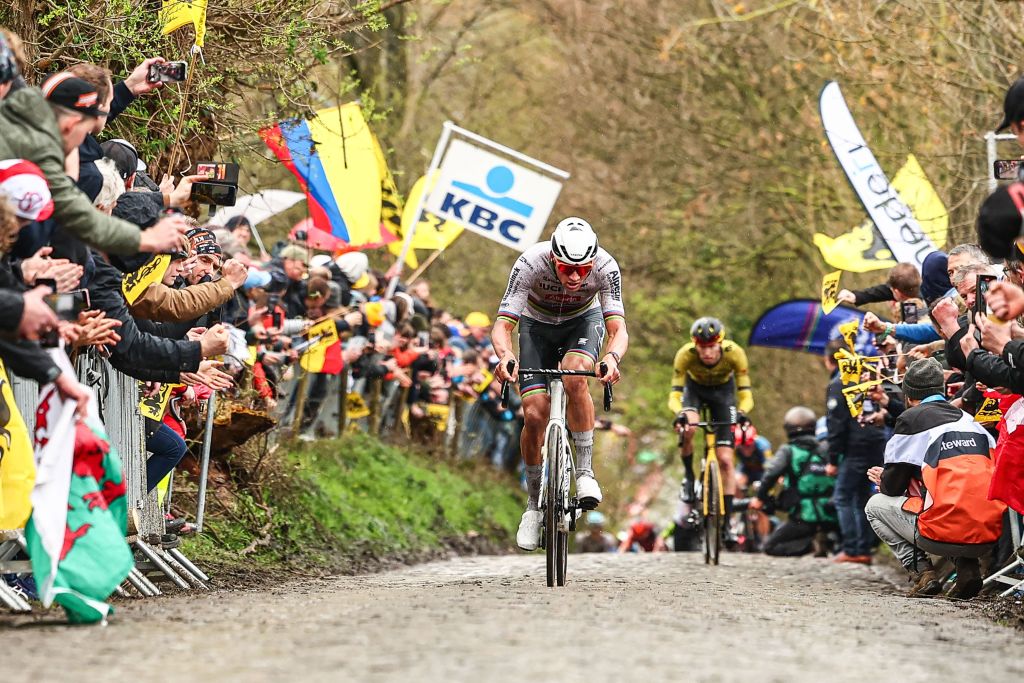
Even the longest races can be distilled to the shortest stretch of road. The Tour of Flanders of 2024 was defined by the wicked slopes of the Koppenberg. Already notorious in the lore of this event, the sharp wall of cobbles outside Oudenaarde added another line to its lengthy rap sheet in Sunday’s rain-soaked edition.
For most, the Koppenberg is a climb to be endured rather than attacked. Here, it was the launchpad for Mathieu van der Poel’s race-winning acceleration with 44km to go as well as the moment most of his rivals’ challenges ground literally to a halt.
There were already murmurs from various pre-race reconnaissance rides that the Koppenberg was liberally bathed in mud this Spring, and the situation wasn’t helped by the deluge that poured over Flanders for much of the afternoon. And besides, even at the best of times, the 20% gradients have been known to compel hardened professionals to dismount and walk.
The tone was set here by Ivan Garcia Cortina (Movistar), who led the race onto the 600m climb after slipping clear of the front group a few kilometres earlier. The Spaniard took on the lower slopes with gusto, only to come to a stop when his tyres lost traction on the steepest section. On dismounting, he tried to release some pressure from his tyres, fearful that the issue would repeat itself later in the race.
“I had no grip, nothing at all. I tried to lower my pressure a bit, but there was nothing I could do. It was impossible,” Garcia Cortina explained with a rueful shake of his head when he arrived in the mixed zone. “I said if I didn’t do that in the Koppenberg, I would probably have that same problem later in the Paterberg.”
As Garcia Cortina grappled with his tyre pressure in the gutter, Van der Poel was settling into the seated acceleration that would carry him to victory. The Koppenberg hasn’t always been to the world champion’s liking during his cyclocross career, but he made relative light of its vicious slopes here, maintaining as brisk a rhythm as the circumstances allowed.
The chasing Matteo Jorgenson (Visma-Lease A Bike) also managed to ride all the way to the top as he battled gamely to limit his losses to Van der Poel, a feat also achieved by Mads Pedersen (Lidl-Trek) despite his exertions off the front earlier in the race.
Behind them, however, came a litany of riders unclipping and walking their bikes up the hill in a desperate attempt to stay in the hunt for a podium spot. They must already have guessed, of course, that Van der Poel’s rainbow jersey would not be seen again before the finish in Oudenaarde.
Indeed, the vast majority of those hunting Van der Poel didn’t even catch sight of him on the climb itself. The Tour of Flanders tends to have that effect, and this was a particularly extreme edition, bedevilled by miserable conditions and constant attacking. By the last 100km here, most riders were wearily chasing the race rather than actively participating in it.
Matteo Trentin (Tudor), 19th, counted himself among their number when he reached the finish of what he cheerfully described as “a bit of a shit day.” Despite his chattering teeth, the Italian paused briefly in the mixed zone to talk reporters through the Koppenberg, though he was unaware at that point that anyone had managed to ride up it.
“With the rain and the mud, you can’t get up. There’s not much you could do,” Trentin said. “I don’t know if anybody managed to get up on their bike. With the mud there was nothing to do, and we were all exhausted by then too. I think everybody was. With the mud, there was nothing you could do. And to be honest, with a race as fast as this, the legs are what they are. Everything was slipping – even the shoes.”
The steepest pitches of the Koppenberg proved too much, too, for the tyres of Magnus Sheffield (Ineos), but the American reorganised himself well over the other side, picking his way through the carnage over the remainder of the race. He eventually battled his way up to the group chasing Van der Poel, helping himself to sixth in Oudenaarde.
Like everybody else who trudged muddied and dazed through the mixed zone afterwards, Sheffield recognised that the Koppenberg had been the turning point of the entire day. A Monument briefly became a footrace, and it was every man for himself.
“There’s the Koppenberg cyclocross race, I think that’s the best way you can describe it,” Sheffield smiled. “Honestly, with road shoes, they’re not meant to run up cobbles, and we were trying to get up as quickly as possible. As soon as I saw guys remount, I tried to do the same. I think at that point Mathieu had already attacked, and from there, we were just trying to chase as best as possible.”
Van der Poel

The Koppenberg didn’t wreak quite as much havoc in the women’s race, won by Elisa Longo Borghini, as it did last year when only two riders rode all the way up. This time, the first ten or so riders managed to grind their way to the top aboard their bikes, though a crash involving Chloé Dygert forced most of the rest of the field out of the saddle and onto their feet, including world champion Lotte Kopecky.
“Koppenberg, we knew we going to be a nightmare,” said Pfeiffer Georgi. “Unfortunately, my running isn’t as good as I’d like. This is only the second year we’ve had it in our race. It's not nice, like when, like last year, only two people didn’t walk up it. It’s obviously an iconic climb, but it’s not the nicest for us when we have to run.”
The Koppenberg was first introduced in the men’s race in 1976, though it was removed from the route again after the 1987 edition when Jesper Skibby fell on the climb and suffered the indignity of having a race commissaire’s car run over his rear wheel. That incident saw the Koppenberg banished from the Ronde for the next fifteen years, returning only after it had been widened and repaved.
It spent another year on the sidelines in 2007, but it has enjoyed an unbroken run in the Ronde ever since. It remains to be seen if Sunday’s scenes will prompt Flanders Classics to rethink its inclusion in the years ahead, given that the race organiser had already seen fit to remove the Kanariebeg and Kortekeer from the 2024 edition due to safety concerns.
Garcia Cortina, the first man to put his foot down, shook his head when the idea was to put to him in the mixed zone. “No, it’s just like this, it’s the same for everyone,” he said. “I think it’s part of the history of the sport.”
Hardly surprisingly, the thought was echoed by Van der Poel when he sat down with reporters after landing his record-equalling third Ronde victory. He has had a sometimes-vexed rapport with the Koppenberg throughout his cyclocross career, but he was in a race of his own once the gradient bit here.
“It was super slippery on the Koppenberg, I also had difficulty to get the power down,” Van der Poel said, before dismissing the idea that its place in the Ronde should be scrutinised.
“I don’t think so. I mean, after a while you can get rid of everything. The road to the new climb, the Kappelleberg, was maybe more dangerous that the roads we did last year. The problem is the riders, not the roads, in my opinion.”
Get unlimited access to all of our coverage of the Spring Classics- including reporting, breaking news and analysis from the Paris-Roubaix, Tour of Flanders and more. Find out more.







